October 2000
Tonight, I can write the saddest lines ……
write for example,
“The night is shatteredand the blue stars shiver in the distance”. But instead,
suffice to say Inna Lillahe Wa Inna Illaihe Rajeoon
|
Dedicated to Mulla Asgharali M.M. Jaffer
Founder and President of The World Federation who died on 21st March 2000 |
In the history of our community, no one man has done so much –
for so many –
with so little
This report is an account of our activities during the last 3 years. It should be read with reference to our previous reports which encompasses our activities from 1979 onwards.
Our Address:
|
Medical Advisory Board
World Federation of KSIMC,
106/108 Anderton Park Road,
Moseley,
Birmingham B13 9DS.
United Kingdom. |
Tel:
Fax:
e-Mail: |
0121 449 2788
0121 449 5988
mab@world-federation.org |
|
|
Web Site |
|
The Medical Advisory Board as other boards is an establishment of the World Federation. The chairman is appointed by the President.
|
Dr Mohamed-Taki I. Walji |
- Chairman |
|
Dr Ahmed Hassam |
- Incharge of Projects |
|
Mr Akil M.H. Rehemtulla |
- Patient Welfare & Liaison Officer |
|
Mr Munirali H. Haji |
- Medical Screening |
|
Mr Azad Rajbhai |
- Patient Welfare |
|
Mr Hasnain Kanani |
- Procurement |
|
Dr Salim Janmohamed |
- MAB Member |
|
Dr Akberali Mithani |
- Overseas Representation & Health Education |
|
Dr Gulamabbas Moledina |
- Overseas Representation & Consultant in Primary Health Care |
|
Dr Gulamabbas Rajpar |
- Overseas Representation |
|
Dr Nawshad Suleman |
- Psychological Screening |
|
Dr Munir Datoo |
- MAB London |
TERMS OF REFERENCE:
1) Help to Patients.
2) Help to health care professionals.
3) Help to the community – Screening, Haj Medical Mission.
4) Help to slum dwellers, poor and refugees.
5) Help to sister organisations.
6) Health Education.
|
All Federations and Jamaats are encouraged to form their own Medical Sub-committees |
Suggested Functions:
1) Liaise with Medical Advisory Board.
2) Provide medical care for the community.
3) Arrange medical screening.
4) Provide clinics/hospitals where needed.
5) Provide health education for the community.
1) HELP TO PATIENTS
Our services to patients from various countries for specialised treatment continue as before. Most patients are self financed but World Federation finances a large number of patients. The amount spent is often quite big e.g. over £ 20,000 per patient in some cases. As the work of Medical Advisory Board becomes known to more and more people, the number of cases referred to us increase hence more and more finance is required. Lack of funds has deprived a number of patients.
Special features:
a) Best medical advice and appointment with UK’s top consultants.
b) Speedy appointments.
c) Low charges and discounts.
d) Free medical assessment and cover out of hospital.
e) Regular friendly and helpful visits by volunteers.
f) Appointment letters for immigration, visa and foreign exchange purposes.
g) Cheap medicines.
h) Cheap accommodation and transportation in Birmingham.
Administrative charge - £60 per person
| YEAR |
COUNTRY WISE ANALYSIS |
|
TYPES OF CASES |
|
| 1997 |
Tanzania |
151 |
Other |
71 |
|
Kenya |
35 |
Heart Disease |
47 |
|
UK |
31 |
Gynaecological Problem |
28 |
|
Pakistan |
29 |
Cancer |
26 |
|
Other |
27 |
Joint Disorder |
22 |
|
Iran |
16 |
ENT Problem |
19 |
|
Iraq |
12 |
Kidney Problem |
15 |
|
India |
8 |
Eye Problem |
14 |
|
United Arab Emirates |
6 |
Neurological Disorder |
12 |
|
|
|
Blood Disorder |
12 |
|
|
|
HIV & Aids |
10 |
|
|
|
Spine Problem |
9 |
|
|
|
Thalassaemia |
8 |
|
|
|
Lung Disorder |
7 |
|
|
|
Liver Problem |
6 |
|
|
|
Mental Illness |
5 |
|
|
|
Skin Problem |
4 |
|
|
___ |
|
___ |
|
|
315 |
|
315 |
| YEAR |
COUNTRY WISE ANALYSIS |
|
TYPES OF CASES |
|
| 1998 |
Tanzania |
144 |
Other |
67 |
|
Kenya |
34 |
Heart Disease |
57 |
|
UK |
26 |
Gynaecological Problem |
25 |
|
Pakistan |
24 |
Eye Problem |
24 |
|
United Arab Emirates |
16 |
Joint Disorder |
19 |
|
India |
11 |
Cancer |
17 |
|
Iran |
9 |
Blood Disorder |
13 |
|
Iraq |
6 |
Neurological Disorder |
11 |
|
Zaire |
4 |
ENT Problem |
10 |
|
Kuwait |
3 |
Lung Disorder |
10 |
|
Oman |
3 |
Spine Problem |
10 |
|
Uganda |
3 |
Kidney Problem |
8 |
|
USA |
2 |
Skin Problem |
7 |
|
Brunei |
1 |
Thalassaemia |
7 |
|
Holland |
1 |
Liver Problem |
3 |
|
Yemen |
1 |
Mental Illness |
3 |
|
Rumania |
1 |
HIV & Aids |
2 |
|
Nigeria |
1 |
|
|
|
Bahrain |
1 |
|
|
|
Zambia |
1 |
|
|
|
Azerbaijan |
1 |
|
|
|
|
___ |
|
___ |
|
|
293 |
|
293 |
| YEAR |
COUNTRY WISE ANALYSIS |
|
TYPES OF CASES |
|
| 1999 |
Tanzania |
144 |
Other |
88 |
|
Kenya |
35 |
Heart Disease |
30 |
|
Pakistan |
16 |
Cancer |
30 |
|
Other |
12 |
ENT Problem |
17 |
|
United Arab Emirates |
11 |
Gynaecological Problem |
15 |
|
UK |
8 |
Eye Problem |
15 |
|
Iraq |
6 |
Joint Disorder |
11 |
|
Oman |
5 |
Spine Problem |
10 |
|
Iran |
3 |
Blood Disorder |
7 |
|
|
|
Lung Disorder |
6 |
|
|
|
Kidney Problem |
6 |
|
|
|
Thalassaemia |
5 |
|
|
___ |
|
___ |
|
|
240 |
|
240 |
1999 Total number of patients treated in Birmingham = 230
1999 Total number of patients treated in London = 10
| YEAR |
NUMBER OF PATIENTS |
TOTAL |
| 1980 |
4 |
4 |
| 1981 |
4 |
8 |
| 1982 |
43 |
51 |
| 1983 |
99 |
150 |
| 1984 |
209 |
359 |
| 1985 |
369 |
728 |
| 1986 |
318 |
1046 |
| 1987 |
412 |
1458 |
| 1988 |
219 |
1677 |
| 1989 |
176 |
1853 |
| 1990 |
168 |
2021 |
| 1991 |
230 |
2251 |
| 1992 |
272 |
2523 |
| 1993 |
267 |
2790 |
| 1994 |
300 |
3090 |
| 1995 |
416 |
3506 |
| 1996 |
299 |
3805 |
| 1997 |
315 |
4120 |
| 1998 |
293 |
4413 |
| 1999 |
240 |
4653 |
|

|
|

|
|

|
|
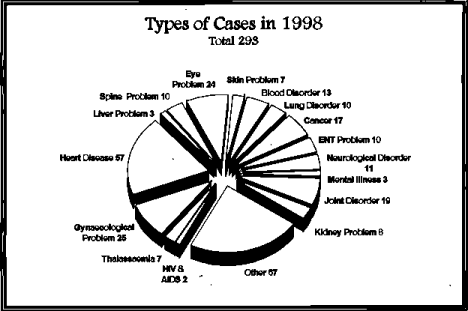
|
|
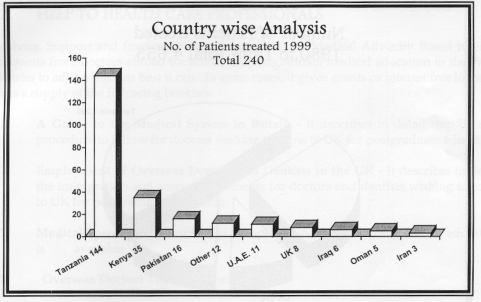
|
|
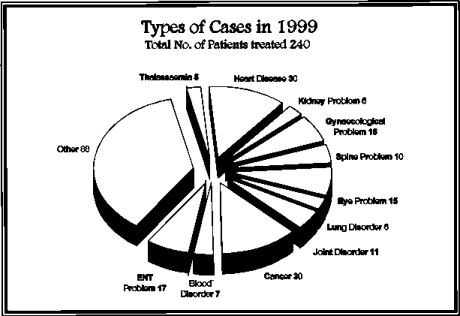
|
|
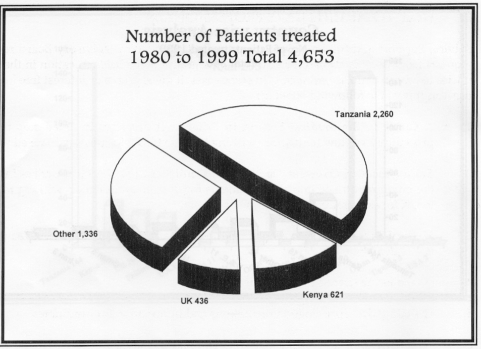
|
|

|
2) HELP TO HEALTH CARE PROFESSIONALS
Advice, Support and finance. From time to time, the Medical Advisory Board receives requests from doctors abroad for advice on postgraduate medical education in the West. It tries to advise them as best it can. In some cases, it gives grants or interest free loans. It has a supply of the following booklets:
1. A Guide to the Medical System in Britain - It describes in detail step by step procedure to follow for doctors wishing to come to UK for postgraduate education.
2. Employment of Overseas Doctors and Dentists in the UK - It describes in detail the immigration and entry requirements for doctors and dentists wishing to come to UK for postgraduate education.
3. Medical Specialities - It describes the specialities in which postgraduate education is available.
4. Overseas Doctors Training Scheme.
5. MRCP (UK) - Examination regulations and information for candidates.
6. Implementing the reforms to specialist medical training.
7. National advice Centre for Postgraduate Medical Education (NACPME) - General information.
8. Opportunities for Clinical Training in the UK.
9. Doctors & Dentists – Information leaflet.
10. Post Graduate Medical School – Information Pack
11. Guide for Doctors new to the UK – Information Pack.
12. PLAB Test Starts in Pakistan – Information leaflet.
They are available free of charge from Medical Advisory Board secretariat.
3) HELP TO THE COMMUNITY
3.1) SCREENING
The Medical Advisory Board of the World Federation has been conducting medical screening programs in most of the Jamaats in UK over the last three years. These are:
Birmingham, Essex, Hyderi, Leeds, Leicester, Milton Keynes, Peterborough, Stanmore,
Watford and Wessex
What is checked?
Height & Weight to calculate BMI (Body Mass Index)
if less than 25 - Normal
more than 25 - Over weight
more than 30 - Obese
Urine Test for Glucose and Protein
Medical Examination
Blood Pressure Measurements
Blood Cholesterol Test
Blood Glucose Levels
Dental Examination
Optical Examination including Glaucoma Test
For women Breast Examination and advise on Smear Test
Thalassaemia Test
NEW: Psychological Screening
Each person is given a summary of the psychological assessment and advice on further action.
RESULTS
From the findings of these numerous screening programmes, we would like to draw the attention of the community to the following issues:
●Obesity
●Rich Diet and High Cholesterol content
●Lack of Exercise
●High Level of Smoking
●High level of Stress
●Poor up take of Smear and Breast Examinations in our ladies
●Poor Eye and Dental check-up uptake
●High incidence of Thalassaemia carrier rate - see health education articles by
Medical Advisory Board.
●High rate of psychological problems which go undetected.
|

|
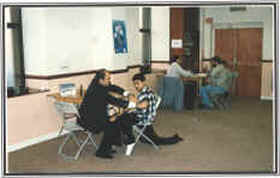
|
|
Screening in action |
The results from these Jamaats have been collected and it has highlighted some interesting points:-
1. The major cause of concern for all our Jamaats is obesity which affects most of those screened. When this is correlated with the incidence of high blood pressure and high cholesterol levels it can lead to angina and heart attacks. Greater emphasis has to be put on dietary advice and lifestyle including exercise to reduce this major problem affecting our community.
|
Food served in Nyaz in our communities is unhealthy |
2. Although there is more awareness on the possible risks associated with smoking either actively or passively, we still have to emphasis this point to our adults and in particular the youngsters, since between 10-30% of males screened actively participated in smoking. The risk of heart disease and lung cancer is greatly increased by smoking.
3.2) HAJ MEDICAL MISSION
 |
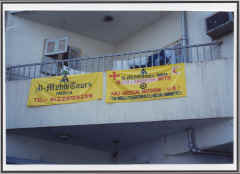 |
Our Team (from left) Dr Abbas Vakil,
Dr Akber Mithani, Dr Gulamabbas Rajpar
and Mr Aliasgar Rajbhai – Haj 2000 |
Our base in Makkah |
For 16 consecutive years (1977 – 1992), The World Federation sent a team of doctors, aalim and administrator to Haj to serve the sick. When it was felt that the community had now become self sufficient, the mission was stopped. However, there was universal pressure to re-start the mission.
On 3rd October 1998, the Executive Council of The World Federation decided to organize a survey to ascertain the health needs of the community worldwide during Haj. Dr Walji did the survey and presented his detailed report to the Executive Council on 10th July 1999. He recommended that The World Federation should send a doctor and/or administrator from its secretariat to help with and co-ordinate doctors accompanying different groups and also assist such group/groups which may not have accompanying doctors or medical supplies. This should be for a few years until it is no longer needed. This was approved.
So, this year saw re-launch of Haj Medical Mission.
Our base in Jarwal in Makkah served Hujjaj from groups which did not have their own doctor and the base in Misfillah served groups from India. A large stock of medicines were made available to the team and given to patients free of charge.
|
See our video on Haj - ONCE IN A LIFE |
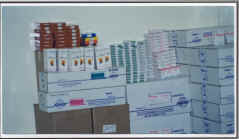 |
 |
Medicines acquired in Makkah for the
Haj Medical Mission |
Dr Akber Mithani treating a patient in Makkah
|
Over 800 patients were treated in both bases. Very serious patients with life threatening conditions attended the clinics. Patients were given prompt attention and a full course of medicines.
In Arafat, number of cases of chest and throat infections, diarrhoea, vomiting, skin rashes and muscular pain escalated. They treated over 1000 patients. Hujjaj appreciated the services provided by the World Federation.
|
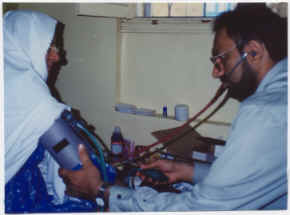
|
|
Dr Abbas Vakil treating patients |
Feedback from the team indicates that this was one of the busiest Haj ever encountered. The groups which did not have their own doctor and the groups from Pakistan used our services extensively. The groups from India were well provided for but because this was our first re-launched mission, it will take time to accomplish stability.
Future
Our next task is to appoint a doctor from Pakistan who will sever the Hujjaj from Pakistan. Once 2 bases are established (one for Hujjaj from Pakistan and one for Hujjaj from India) the team from the Secretariat of the World Federation can then start training them so that eventually our communities worldwide can never face a situation whereby they have no access to a doctor.
Your donation towards Haj Medical Mission will save lives of Hujjaj
The World Federation has achieved another milestone in its charitable work. Following a request from the Tanzania Muslim Haj Trust, The World Federation decided to help.
The Tanzania Muslim Haj Trust group goes to Haj very year. There are a number of disabled people in the group. The disabled therefore need help in doing tawaaf and saii. This becomes very difficult for them because of either non-availability of wheel chairs as well as high charges for those few which are available.
During Haj 2000, The World Federation of Khoja Shia Ithna-Asheri Muslim Communities donated 5 wheel chairs to the Tanzania Muslim Haj Trust. The organization was delighted to receive this gift. Receiving the wheel chairs, the secretary of the trust Haji Abdallah M Jabir thanked The World Federation and said that this will make it easy for their Hujjaj to complete their ahkaams properly. The wheel chairs will be used for the Hujjaj every year.
British Haj Delegation
The British Government through its Foreign and Commonwealth Office, Home Office and House of Lords launched a programme from this year to send a team of doctors, paramedics and helpers to help the British Hujjaj in Saudi Arabia.
The World Federation took active part in the preparation and in formulation of the delegation. The advice from The World Federation from its vast experience of 25 years in Haj Medical Mission was very much appreciated by the government representatives and we were invited to be active participants of this delegation.
| See our Health Guide for Hujjaj and Zawwars |
4) HELP TO SLUM DWELLERS, POOR & REFUGEES
| PRIMARY HEALTH CARE PROJECTS |
4.1) GOVANDI
|
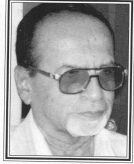
|
Report by Prof. Merchant – in charge of our
Govandi Project |
· Govandi is one of the largest slums in Bombay. It has Shia population of about 25,000.
· our work was mainly in the area of Baiganwadi.
· here health and hygiene standard was poor with almost no sanitation.
· the water supply was by public taps running for a couple of hours each morning.
· the infant deaths were very high.
· birth rates were very high.
· vaccination uptake was very poor.
· preventable diseases like polio, tetanus and measles were very common and killing.
· education background was very poor.
Always, there will be cloudy days.......
but the brave cross the ocean, Always? |
|
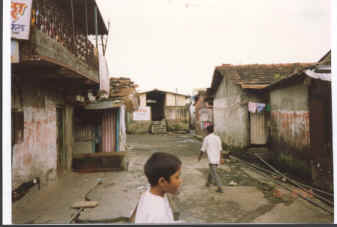
|
The project in Govandi where we alleviate the disease by educating the community on how to avoid or prevent health miseries thereby making them self-reliant is now over. The health education programme is self running and perpetual. The nursery school continues to run whereby basic education along with health education is provided. |
|
Slums of Govandi |
|
AS-SAFEENA EDUCATION CENTRE
Our education centre has four classes and about 300 children and are expanding.
The nursery school is also where we “pick-up” those children who have missed their immunisation or medical check-ups.
This centre was started in 1991. The activities consisted of:-
1) A Balwadi consisting of nursery, junior kinder garden and senior kinder garden classes.
2) A non-formal education class mainly for adolescent girls who could not take up formal education. Here they were taught reading, writing and simple arithmetic, along with some cooking, stitching etc.
This centre was maintained by 1 teacher, 2 social workers and helper.
In 1992 we had only one division each of nursery, junior kinder garden and senior kinder garden classes with a total strength of 72 students.
In May 1993 during the annual holidays our teachers and social workers went around the Baiganwadi area from house to house to motivate the parents, to send their children to our school for nearly free education.
We got a good response form the parents, so we started a second division of each class, by 1995 we had three divisions of each class run by three teachers and a helper.
Due to heavy rush in formal education classes we had to close down the non-formal education class.
People in Biaganwadi never got the Birth Certificate of their children from the Municipal authorities, due to this their children could not get admission in proper schools. It was therefore decided that our teachers should help the parents of students admitted in our school to get their Birth Certificate, by filling in the proper forms, and even accompanying them to the Municipal Offices if necessary to obtain the Certificates.
The teachers were also told to help the parents in getting their children admitted to good Government recognised schools, after they completed their studies in our school.
This was to ensure that these children would continue with their studies, and at least some of them complete their studies.
This idea has been so successful that now most of the parents seeking admission come with the Birth Certificates. Further the number of students seeking admission to better schools goes on increasing every year so much so that in the academic year ending in May 2000, 235 students our of 257 studying in our school got admitted to other schools.
| Year |
No. of students in our school |
No. of students Admitted to other school |
% of students admitted
for further education |
| 1991 – 1992 |
72 |
57 |
79 |
| 1992 – 1993 |
97 |
59 |
61 |
| 1993 – 1994 |
93 |
70 |
75 |
| 1994 –1995 |
125 |
79 |
63 |
| 1995 – 1996 |
223 |
195 |
87 |
| 1996 – 1997 |
95 |
94 |
99 |
| 1997 – 1998 |
259 |
171 |
66 |
| 1998 – 1999 |
185 |
164 |
89 |
| 1999 – 2000 |
257 |
235 |
91 |
This clearly shows that we have been successful in our aim of motivating the people of Baiganwadi to get their children educated.
In order to improve the teaching in our school, our teachers were encouraged to get special training in nursery teaching in 1998. They all obtained a Diploma in Montessori Teachers Training in A Grade.
In 1998, we carried out a survey of Baiganwadi area to find out the number of children under five in the area and the number of them attending any school.
Accordingly a survey was carried out by our teachers for nearly one year, after school hours and during weekly and yearly holidays. The survey covered a population of 8896 in the area.
RESULTS
No. of Families - 1507
No. of People - 8896
No. of Sadat families - 882
No. of Non – Sadat families - 625
No. of children between 2½ to 5 years - 1071
No. of children between 2½ to 5 years attending school - 291
No. of children between 2½ to 5 years not attending school - 780
The results of the survey were really surprising. The survey showed that there were 1071 children eligible for admission to nursery class (about 59% of them being Sadats). But only 291 of these children were attending any school. While 780 of them were deprived of any education. Of the 291 students a majority of 95% were attending our school.
After studying these results, we decided to expand our activities. Hence we have opened a 4th division of each class this year.
The survey seems to have also motivated the parents as there was a very heavy rush for admission this year. Due to this we have been able to admit 360 students in our school. This is the maximum number which can be accommodated in the present school premises, so we had to disappoint many parents who came late for admission.
Due to taking up of more students we had to increase our staff also. At present the school is being run by four teachers. In our future plan we would like to expand our school to be able accommodate more children.
We have now decided to carry out one more survey of the ex-students of our school, in order to find out how far they have been able to continue with their studies. This survey will start soon and though it is a difficult survey as the people of Baiganwadi keep on migrating, we hope to get some result in the year or so.
|
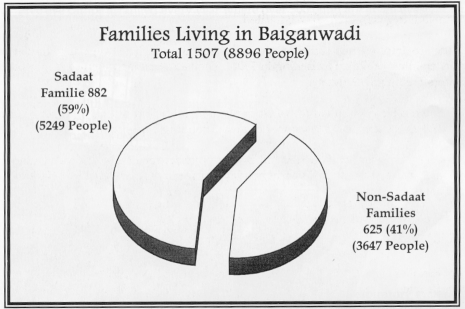
|
|
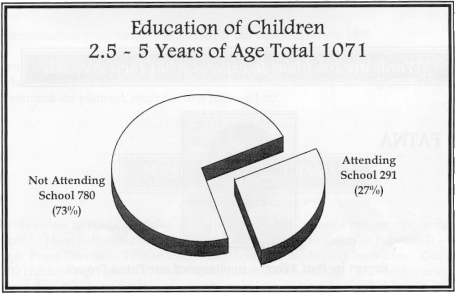
|
These results suggest an urgent need to expand our facilities.
| Please Help! Many Children Come To Our Nursery School Hungry! Without Breakfast! |
|
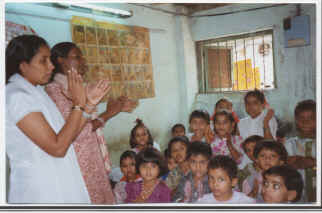
|
|
Our Education Centre in Govandi |
| Words are too blunt to express what their eyes tell |
4.2) PATNA
|

|
Report by Prof Askeri – in charge of our Patna Project |
· Zainabiya Health Centre serves the poor.
· Poor Shias are given basic health care and guided with health education.
· About 1,000 patients are being treated per month.
· Immunisation is promoted vigorously.
· Free eye camps arranged every year where over 300 blind are given eyesight by cataract surgery.
· Free community treatment programme provided special funding for general medical check-ups of the Shias in the villages around Patna.
Zainabiya Health Centre is working at Nauzer Katra Patna since December 1996. General patients are examined, treated and advised. Medicines are also supplied to poor patients. Number of patients examined are:
| Year |
Attendance |
| 1996 - 1997 |
3422 |
| 1997 - 1998 |
4805 |
| 1998 - 1999 |
4573 |
| 1999 - 2000 |
3892 |
| TOTAL |
16692 |
Our analysis shows that the majority of patients suffer from Respiratory systems diseases (6764), followed by stomach complaints (3140), Infectious diseases (2381), Malnutrition/General weakness (1474), Bone & Joint disorder (1256), heat disease (967), etc. TB is endemic too. So far 154 TB patients have been treated.
Immunisation programme was started at our health centre in 1996.
From every patient who attends our centre a detailed history of the patients and his/her whole family is taken and recorded. Full examination, findings, investigations and treatment are planned, recorded and followed up.
PULSE - POLIO PROGRAMME
With a view to eradicate Polio, our Government has started a programme named ‘Pulse – Polio’. Here polio vaccine is given at fixed intervals to children between 0 – 5 years of age. From December 1996 to March 2000 total 13 rounds have been done. Our target was 100 children per round i.e. total 1300 children (in 13 rounds). Our achievement (1384) is more than the target given, average 106 cases per round.
HEPATITIS - B
We are now trying to promote Hepatitis B vaccination to children and adults by making them aware of the dangers of this deadly infection. Some people are responding to our advice, but majority are not because of the cost of this vaccine.
People who attend our health centre are extremely poor. They do not have enough to eat or have clean drinking water. They lack proper clothes, sanitation or shelter. They have no access to medical help. We are struggling to help them help themselves.
EYE SECTION
Zainabiya Health Centre has started the working of its ‘Eye Section’ on a weekly basis from August 1999. A total of 330 patients have been examined from August 1999 to March 2000, which consists of Adult patients 297 (80 male & 217 female) and children 33 (17 male and 16 female).
Disease wise the largest number of patients suffered from eye infections (111) and Cataract. Refraction has been done to 101 patients and appropriate lenses prescribed.
Facilities are available for the visiting eye surgeon to carry our Cataract operations and further examinations if needed, is carried out at the local medical college hospital.
Since 1996, every year ‘eye operation camps’ are organised at Madrasa Islamia, Kujhwa, under ‘Kujhwa Education Society and Charitable Trust’. Patients suffering from eye disease are examined and operable Cataract and Pterygium cases are selected for operation. Fit patients are operated by specialist eye surgeons. Patients are provided with all the facilities required during the operations and postoperative periods. Spectacles are also supplied free of charge.
|
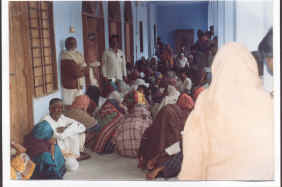
|
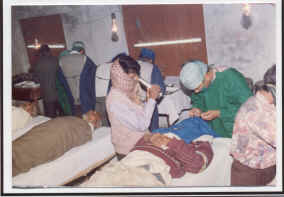
|
|
People waiting their turn for Cataract operation |
Operation in progress |
| Did you know! Your Five Pounds Can Give Eye Sight To A Blind Person! |
4.3) BANGALORE
|
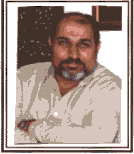
|
Report by Mr Mohamed Mirza Mehdi – In charge of our Bangalore Project |
Neelsandra is a small locality of Bangalore, where a large slum of deprived Shia population of approximately 1,000 families resides, out of a total population of the locality of about 100,000. This is the largest concentration of deprived Shia population in Bangalore.
The condition of the Shia momineen is pitiful and they are staying in unhygienic surroundings. There are no proper roads, or proper water supply and no proper sanitary system. The World Federation has started the Zainabiya Primary Health Centre in 1997 with the following aims and objectives:
a) To bring health awareness to the people of Neelsandra.
b) To provide preventive health care like vaccination, family planning and antenatal care to the pregnant ladies.
c) To ensure proper food habits (nutrition & balanced diet).
d) Provide proper civic services like safe drinking water, proper sewage, drainage and garbage disposals.
e) Arrange camps for mass vaccination.
f) Arrange camps for early detection of illnesses.
g) Group discussions on various health issues and family planning methods
h) Open a clinic and diagnostic laboratory.
The health centre is supervised by Dr Sajjad Husein who visits once a week. The staff consist of a general practitioner, two gynaecologist and two social workers.
The social workers’ job consist of
a. Personal house visits in the locality.
b. Keeping complete statistics of each individual family with regards to their economic status, family size, occupation, source of income, nutrition status, educational status and chronic illness in the family.
c. Ensuring all children are vaccinated regularly and their vaccination records maintained.
d. Advising is given on the importance of personal hygiene and nutrition.
e. Motivating family planning and antenatal care in Zainabiya Health Centre were free of charge.
f. Detecting and reporting and referring communicable disease and chronic illness in the families.
g. Holding group discussions on different aspects of preventive health care like family planning, nutrition, diabetes, hypertension, asthma/allergy.
Zainabiya Health Centre is recognized centre for conducting Government Polio
eradication camps.
Out patient clinics are held 6 days a week. The main focus is on the preventive aspects of health care, like vaccination, nutrition, personal hygiene, screening of communicable disease, etc. The General Practitioner also treats minor illnesses and discourages use of unnecessary medicines. He also guides patients to reference centres.
Two Gynaecologists conduct antenatal and family planning clinic 3 days a week between them. They also treat Gynaecology cases on out patient basis. They recommend and provide all methods of family planning. Pregnant ladies are guided for deliveries to appropriate Maternity Hospitals.
Our Sonologist carries out ultra-sonography once a week, at half the cost. The sonography machine is borrowed from Imam Khomeni Hospital Alipur.
All routine tests are conducted in our diagnostic laboratory. For specialized blood tests, blood samples are collected by our technician and sent to reliable Diagnostic centres at a discount rate.
Recently we have conducted and completed successfully a ‘Hepatitis B’ camp for children of Zainabiya high school. Three doses of the vaccine have been given to all the children. We will be conducting an eye camp soon.
a) 90% of the children in the targeted population have been vaccinated with primary vaccination.
b) More than 50% of the targeted population have been vaccinated against Rubella.
c) The response at family planning clinics have been very encouraging.
d) There has been marked improvement in civic facilities, like regular garbage disposal etc.
e) Emergency Medical Aid for deserving patients is provided.
| Future Plans & Aspirations |
a. To improve the general health and education of the people.
b. To uplift the economic status of the community especially involving the ladies.
c. To open more of such centres in deprived localities.
d. To open an eye clinic and eye hospital.
e. To provide vocational training for women and men to enable them to earn their livelihood.
f. To provide newer vaccinations like HIB and Typhoid.
g. To help provide safe drinking water, improve drainage and garbage system.
The first Medical camp in Neelsandra for ladies and children with the help of 5 doctors including a Gynaecologist and Physician was conducted in June 1997. In Alipur it was held in November 1997. 390 students from Zainabiya high school were examined.
Another camp was conducted in Imam Khomeni Hospital, Alipur in September 1998.
|

|
|
Medical Camp in action |
5) IRAQI REFUGEES IN IRAN
In 1991, after the Gulf war, there was a Shia uprising in Southern Iraq. It was most brutally crushed by Saddam’s army using chemical weapons, tanks and helicopter gunships. Hundreds of thousands of innocent Shias were massacred. Millions began to flee towards Iraq-Iran border. Some made it. About a million Shias - men, women and Children - mostly from Najaf, Kerbala and Basra, previously prosperous sadaats now in most pathetic situation are sheltered in tents in refugee camps scattered along the Iran-Iraq border.
In July 1991, Dr Gulamabbas Rajpar of Sweden and Dr Mohamed-Taki Walji from UK of the World Federation visited most of these camps and witnessed the horror of this most brutal and unjust war first hand.
· 1991 Gulf war has resulted in hundreds of thousands of refugees.
· They are all Shias and big proportion are sadaats.
· They are accommodated in most pathetic conditions in tenets, huts and tin containers in a dozen or so refugees camps along Iran-Iraq border.
· Iran government provides bare minimum provision.
· World Federation tries to provide medicines.
|
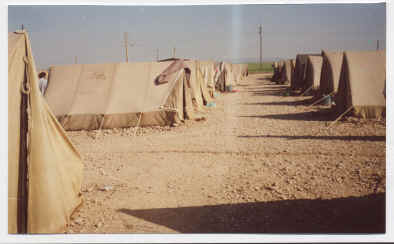
|
| Iraqi Refugee – Still ‘housed’ in tents. |
The world is a little too unequal, a little too unjust,
a little too exploitive |
The world has forgotten the plight of these Shias. The number of refugees has increase many fold because of Saddam’s atrocities on Marsh Arabs of Southern Iraq. The government of the Islamic Republic of Iran is shouldering the burden of maintaining these refugees. The government is doing more that it can do or afford. The international community and the rest of the world including the rest of the Muslim world continues to ignore them. The refugees are short of every human need imaginable. The worst aspect of this tragedy is that they are dying due to lack of simple medicines like antibiotics, asthma inhalers, diabetes medications etc.
5) HELP TO SISTER ORGANISATIONS
5.1) AFRICA
5.1.1) Central Health Broad of Khoja Shia Ithna-Asheri Supreme Council
The following are present members of the Board and their portfolios:-
|
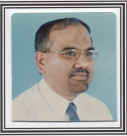
|
Mr Aunali K. Khalfan - Chairman
|
| Mr Inayat Alidina |
- Hon. Secretary |
| Dr Jamil Merali |
- Medical Advisor |
| Dr Dilawer Padhani |
- Medical Advisor/Health Education |
| Dr Mahmood Hameer |
- Special Project Development |
| Mr Fazelabbas Dhirani |
- Special Project Development |
| Mr Razahussein Manji |
- Medical Bulletin/Publications |
| Mr Mohamed Mulla |
- Physical Fitness Activities/Conventions |
| Mr Shakil Dharamsi |
- Health Screening/Blood Grouping |
| Mr Hassan Raza |
- Health Screening/Medical Library |
| Mr Mohamed Pirbhai |
- Ex-officio (Vice Chairman of Africa) |
MEDICAL ADVISORY PANEL (MAP)
The panel members are nominated by the Chairman of the Central Health Board. The following are members of the panel:-
Dr Mahmood Hameer
Dr Zulfikar Abbas
Dr Jamil Merali (Co-ordinator)
MAP guides patients who seek medical assistance for treatment abroad and within the country and when required, provides guidance to the Jamaats for welfare patients.
OBJECTIVES
Following objectives and targets were set by the CHB.
1) Improvements and expansion to the existing facilities provided by the CHB to patients in India in terms of accommodation facilities, appointments with specialist, and general welfare.
2) Re-introduce Health Screening Projects for those Jamaats requiring assistance. To begin in 1999 with Dar es Salaam, Zanzibar, Tanga, Morogoro and Dodoma. Encourage other Jamaats having facilities to do the same with a major focus on preventive healthcare.
3) Intensify health education in areas like HIV & AIDS, Heart diseases, Thalassaemia etc. Prepare a 3-year programme for the youths, ladies and gents population of our community in Africa.
4) Assist Jamaats, which require guidance and support to set up Dispensaries and Clinics in their respective towns/cities.
5) Appoint expert individual and group counselling in Health and Sex Education for all age levels and groups of youths and school children of both sexes.
6) Propagate and encourage constituent Jamaats that do not have sports and recreation amenities to provide such facilities for ladies and gents members of the community of all age levels.
7) Continue to promote closer working relationships with MAB of the World Federation and Imaan Foundation in India for the mutual benefit of our organisations and community members.
8) Establish Medical Reading Library for the medical professionals and students in Africa with the assistance of MAB and other organisation worldwide.
9) Encourage and support medical professionals and students for field trips, training attachments, placements etc. By liasing closely with Jamaats, MAB, NGOs etc.
10) Continue to publish the quarterly CHB Medical Bulletin for our community members, solicit advertisers to cover part of the printing cost.
11) Establish database of the health status of our community - typical causes of deaths, common diseases obtained out of the results of the Health Screening programmes and advise corrective and remedial action.
12) Organise Medical Convention involving health care professionals, heads of our community, social workers etc. once every three years and prepare/adopt action plan.
| HEALTH EDUCATION & LECTURE PROGRAMMES |
CHB continues to offer health education and health awareness programmes for the youths and the community at large. Jamaats are encouraged to give priority and to organise such programmes through their medical and educational institutions. Following programmes were held until April 2000 with the collaboration of Dar es Salaam Jamaat: -
1. Dental Hygiene: by Dr. S. Mohamedali
2. Common ENT problems: by Dr. M. Datoo
3. Appendicitis: by Dr. Sayed Iqbal Ali
4. Smoking and its Effects: by Dr. Mahmood Hameer.
5. Treatment of heart diseases without surgery: by Dr. Shoaib Padaria
6. Preventive Health Care and MAB activities: by Dr. Mohamedtaki Walji
| LECTURE PROGRAMME FOR STUDENTS |
Lecture programmes have been introduced for the Husseini Madressa boys’ section. Professional Medical Practitioners are invited to speak on different topics. Topics are selected according to age group, this was introduced since last year. The next step is to arrange for lady doctors to do similar programmes for the Girls Section. The challenge to all Jamaats is now to focus and introduce Health and Sex Education in the curriculum of all our religious and secular institutions. Similar lectures will be introduced at the Al-Muntazir Islamic Seminary for boys and girls in the near future.
| YOUTH - HEALTH AWARENESS SYMPOSIUM |
CHB in collaboration with the Ithna-Asheri Union Literary Section and Husseini Madressa organised a symposium on 9th April 2000 at the Al-Muntazir Complex in Dar es Salaam. The theme of the symposium was – “ Vision 2000 and the Emerging Dilemmas of the Youths”. Three papers were presented, one by Dr. Zulfikar Abbas on health issues, Maulana from Washington, Sayed Rafiq Naqvi talked on Spiritual and Moral issues and Representatives of the youth, Br. Mazaher Tejani and Br. Hussein Khimji on the Dilemmas of the Youths. An open session including question and answer session was conducted after the lunch. About 125 youths took part. Africa Federation and Dar Es Salaam Jamaat leaders were also present throughout the symposium.
Dar es Salaam Jamaat in collaboration with CHB, have introduced a 25 minutes monthly lecture programme followed by discussions in the Mosque after maghribain prayers covering different topics on healthcare and diseases. The attendance and interest shown so far is encouraging.
| PRE-MARITAL TESTING FOR HIV/AIDS |
Following the Resolution in April 1998 session of the Supreme Council held in Dar es Salaam, the pre-marital testing of HIV/AIDS in all Jamaats of Africa Federation was introduced. It is encouraging to note that members have been co-operating with the Jamaats in the implementation of this Resolution. In view of the increasing number of cases of HIV & AIDS in our community world wide, the Executive Council of the World Federation also passed a resolution on 3rd October 1998 in Peterborough requiring all member Jamaats and Federations to seek from the bride and groom evidence of their being free of HIV & AIDS virus and that both are not Thalassaemia carriers.
5.1.2) TANGA
Unfortunately, Jaffery Charitable Dispensary, which started in 1970’s, had to be closed down in April 2000. The Jamaat aim to help the needy patients in any way it can and also assist those who require treatment abroad.
5.1.3) DAR ES SALAAM
Ebrahim Haji Ithna-Asheri Charitable Health Centre was established in 1959, first as an Ebrahim Haji Ithna-Asheri Charitable Dispensary.
FACILITIES
· Full time doctors
· Specialist Doctors
· In-patients Department
· Out-patients Departments
· Basic laboratory with Haematology and Biochemical facilities (24 hours service)
· Pharmacy (24 Hours service)
· Intensive Care Unit
· Ultrasound
· Echo - Cardiography
· Colour Doppler
· ECG
· 24 Hours Ambulance Services
· Operating Theatre
· Maternal and Child Health Service
· Dental Clinic
· Physiotherapy
· Radiology
· TB clinic
FUTURE PLANS
a) Full-fledged Operation Theatre.
b) Modern laboratory.
c) Blood Gas and Microbiology facilities.
d) Complete Radiology service.
e) Modern Intensive Care Unit with good quality bedside Cardiac monitors and pulse Oxymeters.
f) Maternity facilities.
The following are the Medical Board members:
| Dr Mustafa Virani |
– Chairman |
| Mr Muhsin Abdallah |
– Vice Chairman |
| Mr Inayat Alidina |
– Hon. Secretary |
| Mr Ahmed Khaki |
– Hon. Treasurer |
| Dr Z.G. Abbas |
– Member |
| Dr Karim |
– Member |
| Mr Aliraza Rajani |
– Member |
5.2) NORTH AMERICA
NASIMCO has appointed Dr Haider Fazal as Chairman of MAB Nasimco.
Its aims are:
1. Liaise and co-ordinate activities with jamaats and health professionals in North America.
2. Provide advice regarding medical cases locally and abroad.
3. Provide screening/information for medical ailments.
4. To provide medical assistance/advice/immunisation to Hajjaj and Zawwars.
5. Raise funds for medical relief/aid for needy communities.
6. Obtain medical supplies and literature for needy communities.
7. Facilitate visits by health professionals to needy communities.
Work done so far include:
a) Financial support to various projects in India and Africa
b) Medical supplies and literature to East Africa
c) Regular medical lectures and seminars for our community.
d) Fund raising activities.
5.3) EUROPE
The Council of European Jamaats has formed a Medical Awareness Committee.
|
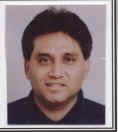
|
Dr Hussein Jiwa - Chairman (Osteopath – Peterborough) |
MEMBERS
| Mr Mehboob Dattoo |
- Vice Chairman (Pharmacist – Peterborough) |
| Dr Yousuf Bhimji |
- Member (General Practitioner – Birmingham) |
| Dr Minaz Bhimji |
- Member (Consultant Anaesthetist – Birmingham) |
| Mr Naseen Valji |
- Member (Pharmacist – Essex) |
| Mr Mohamed Bhimani |
-Member (Pharmacist – Peterborough) |
| Mr Iqbal Manji |
- Member (Social Worker – Peterborough) |
| Dr Murtaza Walji |
- Member (Dentist – Peterborough) |
| Dr Tahera Bhojani-Lynch |
- Member (Ophthalmologist – Leicester) |
ACTIVITIES
A number of initiatives have been implemented and carried through to satisfactory conclusion. The account below is an indication of the work of the committee by no means includes all the aspects of involvement of the individual members in serving the community.
HEALTH AWARENESS SEMINARS
A number of health seminars have been organised for member jamaats of COEJ. The topics covered have included:
i) Aids
ii) Thalassaemia
iii) Drug Abuse
iv) Diabetes
v) HRT & Menopause
vi) Cancer including Breast Cancer & Cervical Cancer
vii) First Aid
viii) Healthy Diet
ix) Medical aspects of Ghusal & Kafan
In September 1999, a lady doctor and a male doctor attended the youth camp organised by the Council of European Jamaat for boys and girls at the Kingwood Centre in Staffordshire. A variety of health related topics were debated and discussed. The topics in particular included aids and Thalassaemia, in light of The World Federation’s initiative on implementing mandatory testing for these conditions for prospective marriage partners.
| MEDICAL COVER FOR EUROPEAN HAJ MSSION |
Medical cover has been provided during Haj pilgrimage to the Hujjaj belonging to various groups from Europe and also the Hujjaj from other countries needing medical attention. The medical services provided have included pre-travel Haj seminar and advice, health screening for the kafela members and health monitoring and treatment as and when required during the Haj. The medical support has included doctors and pharmacists who are available on 24-hour call basis. All necessary drugs are donated by monineen and are dispensed free of charge. If patients require hospitalisation the medical team liaise with the local hospital doctors and makes all the necessary arrangements.
| Health Screening & Health Information |
We have assisted the Medical Advisory Board of The World Federation with health screening organised for different jamaats in UK.
A booklet on aids on behalf of Medical Advisory Board was published in 1996 and to-date the uptake of this literature has been very encouraging.
Health related articles are published in COEJ Newsletter distributed to the affiliated jamaats in Europe.
FUTURE DEVELOPMENT
The MAC encompasses a wide skills mix and experience and is able to offer a comprehensive medical and related services to the community it serves. Recognising the fact the MAB is extremely busy with a variety of numerous demanding commitments worldwide the MAC has recently put forward a proposal for sharing some of the burden locally within the UK. The implementation of the proposal will only be possible with the blessing, advice, guidance and support of the Medical Advisory Board
6) HEALTH EDUCATION
6.1) THALASSAEMIA
Thalassaemia is a condition of blood that is found in many countries around the world and particularly in people of Mediterranean, Middle Eastern or Asian origin. It is found in our community too. It is an inherited genetic blood disorder. There are many forms of Thalassaemia but the commonest forms are Alpha and Beta Thalassaemia. Alpha rarely causes any illness. There are two types of Beta Thalassaemia.
Beta Thalassaemia Trait
People with beta Thalassaemia trait are not ill. They are absolutely healthy and normal but some of them have slight anaemia. They do not know that they are carriers unless they have a special blood test carried out.
The difference between a carrier and a non-carrier is that the red cells of the carrier are slightly smaller than those of a non-carrier. This is sometimes mistaken for iron deficiency anaemia and iron is prescribed. If a couple is tested and one partner proves to be a carrier then there is no danger to their children. But if both partners are carriers then there is a 25% chance of each pregnancy to produce a child with Thalassaemia major. It is important for you to know that you are a carrier.
Beta Thalassaemia Major
This is a very serious blood disorder which children are born with and it begins to show in early childhood. Children who have beta Thalassaemia major cannot make enough haemoglobin in their blood. They need frequent blood transfusions and other medical treatment. Most children who have these transfusions grow normally and live quite happily in their early teens, but to live longer than twenty they need other treatment as well like bone marrow transplant, operation to remove the spleen and other more drastic treatment.
Everybody should find out more about Thalassaemia even if planning a family is not contemplated at this stage. We thoroughly recommend that every person should have the Thalassaemia test.
How is Thalassaemia Passed on
Every characteristic of the body is controlled by ‘genes’ which is present in every cell. There are always 2 kinds of genes - one passed from the mother and the other from the father. Among many other genes there are 2 genes present to control how haemoglobin is made in the red blood cells.
‘Normal’ people are normal because they have 2 normal genes for haemoglobin from each parent. Those who have one normal gene from one parent and one altered or abnormal gene from the other parent are healthy because one gene is working well. They are said to be healthy carriers of Beta-Thalassaemia Trait. Since gene is inherited from each parent, at least one parent must be a carrier. People with Beta-Thalassaemia Major have 2 altered genes from haemoglobin, one inherited from each parent, so both their parents must be carriers.
¨ When both parents are normal - they cannot possibly pass on Thalassaemia Trait or Thalassaemia Major to their children.
¨ When one parent has Thalassaemia Trait and one is ‘normal’ - 50% of children will be Thalassaemia carriers.
¨ When both parents are Beta Thalassaemia carriers - they are a ‘couple at risk’ - 25% of children will be normal, 50% will be Beta-Thalassaemia carriers and 25% will have Thalassaemia Major. It is possible to test the foetus during pregnancy to see if it has Thalassaemia Major.
How Does Thalassaemia Affect Our Community
|
No. of jamaats screened in UK (Birmingham, Essex, Hyderi,Leicester, Leeds, Milton Keynes, Peterborough, Stanmore & Wessex) |
9 |
| No. of people who attended the screening programmes |
1753 |
| No. of people who had Thalassaemia test. |
1201 |
| No. of people whose blood sample was insufficient and need to repeat the test. |
15 (1%) |
| No. of people who had successful test |
1186 (99%) |
| No. of people who were too anaemic to have the test (they need Iron supplement before repeating test). |
104 (9%) |
| No. of people who were not affected by Thalassaemia |
977 (82%) |
| No. of people with Thalassaemia Trait. |
105 (9%) |
|

|
IMPLICATION FOR OUR COMMUNITY WORLD WIDE
These results suggest that over 9 out of 100 people in our community are definitely Thalassaemia trait carriers. This figure is possibly higher - as high as over 18 out of 100. If 2 carriers marry, their children will have a 25% chance of producing children with Thalassaemia Major. This would be major disaster for them as well as for the affected child.
Recently, we in the medical Advisory Board have received several children (patients) from our community world wide for treatment of Thalassaemia Major. Many have died. The treatment is extremely painful and expensive.
IT IS THEREFORE VERY IMPORTANT TO AVOID MARRIAGE BETWEEN TWO THALASSAEMIA CARRIERS.
Thalassaemia status can only be ascertained by a blood test.
We therefore recommend that all intending brides and grooms should undergo a Thalassaemia blood test before getting married. We also recommend that Thalassaemia screening should be carried out throughout our community.
Since the increase of HIV and AIDs is also increasing in our community, they might as well have Aids test too after full counselling.
Since the likelihood of Thalassaemia occurring in an extended family is higher than average, cousin marriages should also be avoided.
The following leaflets are available free from the Medical Advisory Board secretariat in Birmingham:-
1) Birmingham Sickle Cell & Thalassaemia Centre Information Booklet.
2) You could be a carrier of Thalassaemia
3) Thalassaemia - English, Gujarati, Hindi & Urdu.
4) All you need to know about Beta-Thalassaemia Trait - English, Gujarati, Hindi & Urdu.
5) What is Thalassaemia?
6) Alpha Thalassaemia
7) Tied for Life because of Thalassaemia
8) Bone Marrow Transplantation for Thalassaemia
9) Living and Coping with Thalassaemia
10) Fathering Babies
11) Thalassaemics Adolescence and Hormones
12) Gene Therapy for Thalassaemia
13) Cardiac Complications
14) Bone Marrow Transplantation Fetal Blood
15) Clinical Trials of Deferiprone (L1)
16) UK Thalassaemia Register
17) Thalassaemia & Fears
18) Beta Thalassaemia Intermidia
19) Thalassaemia Historical Background
20) Having Babies
21) Beta Thalassaemia
22) Haemoglobin H Disease
23) What is Thalassaemia (Thalassaemia on-line)
24) Accessible Publishing of Genetic Information web-site is http://www.chime.ucl.ac.uk/APoGI/
25) Thalassaemia Asian Awareness Campaign
26) Thalassaemia Background to Thalassaemia
27) Thalassaemia Clinical Fact Sheet
28) Prenatal Diagnosis for Thalassaemia Major
Videos available on loan:-
1) Blood Ties - English
2) Why you need to know about Thalassaemia - English & Gujarati
| Thalassaemia screening in Mumbai |
Thalassaemia screening was recently started in Mumbai in our community.
Results received so far:
| Tested |
Screened |
Abnormal Results |
% Carrier of Abnormalities |
| Khoja Shia |
1163 |
251 |
22% |
| Non-Khoja Sayyid & Non Sayyid |
6337 |
41 |
12% |
Those with abnormalities will be further analysed to ascertain weather they are carriers of Thalassaemia. Majority will be.
Thalassaemia screening was recently done in Mumra.
Results received so far indicate carrier rate of abnormalities of similar scale:
6.2) HIV & AIDS
As far back as early 1990, the Medical Advisory Board of the World Federation had brought up the subject of HIV & AIDS in our community for discussion in one of the Executive Council meetings held in Peterborough. It drew peoples’ attention to the fact that if no urgent action is taken, this deadly infection will affect our whole community. The audience were shocked to hear this and some found it difficult to believe that such a disease can penetrate our community. Some, later on, accused us of spreading panic in our community.
Alas, HIV & AIDS has indeed already penetrated our community and got hold of it. So far we have received 98 cases of HIV & AIDS at the Medical Advisory Board. Most of them have died.
This is ofcourse a tiny fraction of what the real figures are. Our estimate is that over a thousand people in our Khoja Shia Ithna-Asheri Muslim Community world-wide is affected by HIV & AIDS at the moment. This is the most conservative figure. Other doctors working very closely with our community put prevalence to 3%.
| Year |
No. Patients |
Total |
| 1991 |
2 |
2 |
| 1992 |
6 |
8 |
| 1993 |
8 |
16 |
| 1994 |
13 |
29 |
| 1995 |
17 |
46 |
| 1996 |
19 |
65 |
| 1997 |
21 |
86 |
| 1998 |
60 |
146 |
| 1999 |
74 |
220 |
|
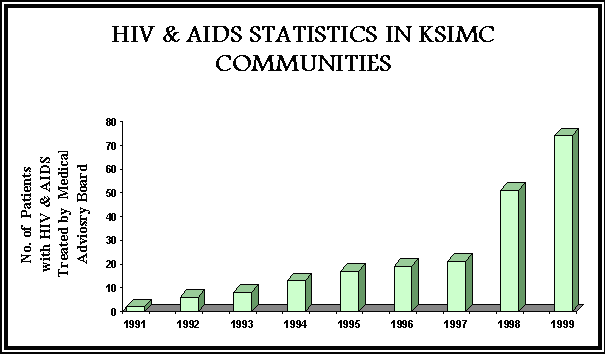
|
Now, marriages are ending up in divorce and engagements are being broken because one of the partners is HIV positive. Aids is being passed on to the off spring.
Now in our communities:-
· AIDS is being passed on to children from mother.
· Engagements are broken because one of the partner is HIV Positive.
· Marriages are ending in divorce.
Some of the facts about HIV & AIDS
1. The first fact about AIDS is that AIDS is now a fact of life. Too many people still think of it as a disease which “other” people contract.
2. Society’s reaction to AIDS have varied from shock and fear to complacency. As we are a close knit community HIV and AIDS can be particularly important issue. No doubt, strict adherence to Islamic teachings will save us from this dangerous disease.
3. As yet there is no cure for HIV (which leads to AIDS) so there is only one way to combat the disease. That is to prevent it from spreading. AIDS kills. Once infected, always infected.
4. AIDS is a world-wide problem amongst people of all ages. Early cases were found in drug abusers, blood transfusion patients and people who practised high risk sexual activities such as homosexuals and prostitutes. But now HIV is being spread through conventional sex - between men and women.
5. HIV (Human Immunodeficiency Virus) is the name of a virus that can damage the body's immune system. The immune system fights off illness, and if the body's defences are severely weakened this can lead to AIDS (Acquired Immune Deficiency Syndrome). AIDS is the name for a collection of different diseases which can cause serious illness or death in both adults and children.
6. In adults, a test for HIV antibodies will not produce a positive result until at least 3 months after infection and this is called the "window" period. It is important to remember that even though a test result would be 'negative' during the "window" period, a person would be infectious at this stage, if they have HIV. People who develop AIDS become ill from a variety of problems which they cannot fight off and from which they eventually die. Two illnesses which commonly affect AIDS patients are a type of pneumonia called Pheumocystis Carinii, and a form of cancer which attacks the skin called Kaposi's Sarcoma.
| DEATH OCCURS WITHIN 3 YEARS OF GETTING AIDS. |
How is HIV Transmitted
* through unprotected vaginal or anal intercourse with an infected man or woman.
* by infected blood entering the blood stream through sharing injection needles, transfusion of infected blood or blood products, intravenous drug users (those who take injections regularly for pleasure), needle injuries, etc. Check if blood or blood products are screened in your country.
* from a woman with HIV to her baby either during pregnancy, or during delivery.
WHO IS AT RISK?
People who:-
a) Have sexual intercourse with an infected man or woman.
b) Use intravenous drugs.
c) Share injection needles.
d) Have a transfusion with infected blood or blood products.
e) Have frequent sexual intercourse with many partners.
f) Have sexual intercourse with prostitutes.
g) Indulge in prohibited sexual behaviour e.g. homosexual intercourse, oral
sex, anal sex, etc.
h) Are born to infected mothers.
PREVENTION
1. The Islamic life style - chastity before and fidelity within a marriage - is a safeguard against acquiring this disease. Live within the bounds of The Islamic Shariah and adhere to the injunctions prohibiting homosexuality and extramarital sexual relations. Despite the alarming aspects of this illness it is reassuring to know that we have the ability to choose to avoid AIDS and the answer lies in ‘living within the precincts of the moral code’ as prescribed by Islam and upholding the values of chastity and morality. Being faithful to ones wife or husband is the best ways of prevention.
2. If your use a condom use it correctly. Use water based lubricant gel with the condom. Oil based gel can weaken the rubber.
3. Remember - many signs and symptoms of AIDS coincide with wide variety of illness and therefore early medical help should be sought where suspicion arises.
4. Have screened blood transfusion. Except in life threatening conditions, a blood transfusion for any purpose should be refused unless it has been guaranteed to have been screened for HIV. Where in doubt, it is always advisable to arrange donors within family or community whose health status is known.
5. Don’t use intravenous drugs. Do not share your needles, syringes, mixing bowls etc., if you happen to use intravenous drugs.
6. Do not share Razors, toothbrushes and towels.
7. Do not share Zanjeers or go too close to the user.
AIDS IS A KILLER
It kills individuals, families, generations and societies |
6.3) CARING FOR THE MUSLIM PATIENTS
The World Federation was invited and represented in the launch of the book “Caring for the The Muslim Patient” in the House of Lords on 18th July 2000.
The book was launched by Lord Weatherill and Lord Hunt. The book addresses common misunderstandings, difficulties and bridges cultural gaps. Muslim patients customarily have particular ways of approaching health and healthcare. It includes a profile of the Islamic worldview, taking an ‘insiders perspective’ and explores the concept of health and disease within this paradigm. Muslim practices and customs of direct relevance to health and healthcare are also explored and illustrated with case histories. The book offers practical advice to enable all healthcare professionals in hospitals and in the community to provide care in a culturally appropriate manner.
The book’s message is to show the sensitivity and insight in to the Muslim faith and how it relates to health in Britain today. The book also shows that both knowledge and insight are required to cater positively for patients with a wide diversity of beliefs and practice in a multi-cultural society.
6.4) HEALTH EDUCATION ON THE BBC
The World Federation is invited to participated on health issues affecting our community in the media from time to time. In May 2000, The World Federation was invited and took active part in the health issues broadcast on the BBC on the subject of health issues related to Cousin Marriages.
6.5) COUSIN MARRIAGES (CONSANGUINEOUS MARRIAGES)
Our Holy Prophet Muhammad Mustafa (S.A.W.W) has said, “........don’t get married to a very close relative because the offspring of such marriage will be weak. Defects out of such marriages will not be rectified until 3 generations of marriages of non-relatives”. (Nafhaatun Muhammadia by Muhammad Jawad Maghniya - Pg. 156).
One of our Mujtahedeen Ayatollah Syed Naasir Makarim Shirazi has studied this subject in detail and has recommended that cousin marriages should indeed be avoided (Falsafa-e-Ehkaam by Ayatollah Nasir Makarim Shirazi: Pg. 119-122). He says that according to various narrations of our Aimmah, cousin marriages should be avoided. When we asked Agha directly, he wrote to us saying “........such marriages have been discouraged in some of the traditions (ahaadiths)”.
Cousin marriages are also known as consanguineous marriages. The practice of such marriages is very old indeed and has cultural/religious ties too. In some religions, it is acceptable e.g. Islam whereas in Hinduism, it is forbidden.
Cousin marriages are common in our community too. In the past they were even more common. Reasons given include:-
a) Better to marry in a family we know so that the bride/groom can adjust to their new life easily.
b) Better marry within the family so that our ‘wealth’ does not go out.
c) Better marry within the family because we are better/superior than others.
d) Better marry within the family so that should disputes arise, they can be settled easily, hence reducing the likelihood of divorce.
e) If a girl or a boy has physical or mental defect, then he/she is married off within the family where force can be applied - (inadvertently increasing the chance of defective children).
f) Agreements made by parents who are usually related.
g) Our Aimmah have done so.
Cousin Marriages Should Be Strongly Discouraged.
Some of the reasons of such marriages given above may be plausible like the boys’ and girls’ knowledge of each other’s cultures but surely this can be achieved without marring within a family. Other reasons given are rather selfish and perhaps immoral. It is indeed immoral to pursue such marriages and risking lives of off springs in order to preserve one’s wealth or vanity. Our Aimma have married within the family (only 2 of them) but have discouraged them. They were pure (Aayat-e-tatheer). Are we?
Medical research has shown that such marriages should be avoided because children born in such marriages are adversely affected. They have increased chance of being
●physically retarded
●mentally retarded
●have defects like blindness, deafness etc.
Evidence
1) Professor Sarah Bundey of Birmingham University has done an in-depth study of 5,000 cousin marriages and has found that children born out of cousin marriage are more likely to be defective - more so compared to non-cousin marriage. The risks are highest in first cousins i.e. to marry ones father’s or mother’s brother’s or sister’s children.
2) We have abstracts of 19 published research papers demonstrating increased incidence of birth defects in children born out of cousin marriages.
3) A recent study of British Pakistanis has shown an increasing trend of cousin marriages i.e. 33% in Pakistan but 55% in Yorkshire! Journal of Medical Genetics. 1988,25,186-190.
4) Incidence of Cancer and birth defects in children born in cousin marriages have been found significantly higher. (British Journal of Cancer (1995) 72, 1563 - 1569). Archives of Diseases in Childhood 1994; 71: 398 - 403. Ciba Foundation Bulletin No. 29 Pg. 11.
5) In Lebanon, such marriages are discouraged. It is now a legal requirement for couples to be tested for hereditary disorders like Thalassaemia, Sickle Cell disease, asthma, eczema haemophilia, epilepsy, some specific cancers etc. before they can marry. (The Lancat. Vol. 344 November 19, 1994 Pg. 1426)
6) Consanguineous marriages can increase the risk of inherited diseases in the offspring. Perinatal mortality is high among British Pakistani population largely due to an increased incidence of congenital malformation. About half of this excess is associated with parental consanguinity. There is also considerably greater increase in congenital disorders and handicapping disease, and most of the excess appears to be associated within parental consanguinity. (Social and genetic implications of customary consanguineous marriages among British Pakistanis. Galton Institute. Occasional papers. Second Series. No. 4 March 1992).
It is therefore very important to avoid cousin marriages. However, it is not haraam and such marriages cannot be stopped by force.
It is vital that our community is made aware of dangers of such marriages.
The incidence of Thalassaemia is very high in our community (see our article on Thalassaemia). The likelihood of the couple (both - the girl and the boy) to be Thalassaemia carriers is high if they are cousins and such marriages can lead to the offsprings suffering from Thalassaemia Major which would be a major disaster for the child as well as the parents.
We would therefore recommend:-
Avoid Cousin Marriages.
●If this cannot be avoided, ensure that (a) there is no family history of inherited diseases like Thalassaemia, Sickle Cell disease, asthma, eczema haemophilia, epilepsy, some specific cancers etc. in one of them - the boy or the girl. (b) the couple undergo blood tests and counselling.
●If there is family history of inheritable disease in both of them or if the blood tests are positive, such marriages must be stopped.
Articles and leaflets available free from Medical Advisory Board Secretariat.
1. GP Medicine Research - “GP struggles to keep cousins apart”. GP August 13, 1993 Pg. 24.
2. Cousin Marriages - English & Urdu.
3. A Guide to Clinical Genetics and Genetic Counselling.
4. Social and Genetic implications of customary cousin marriage among British Pakistanis.
5. Race, Consanguinity and Social Features in Birmingham Babies: a Basis for a Prospective Study by Prof. Sarah Bundey.
6. A Five Year Prospective Study of the Health of Children in Different Ethnic Groups, with Particular Reference to the Effect of Inbreeding by Prof. Sarah Bundey.
Following health education leaflets specially written for our community are available from the Medical Advisory Board Secretartiate free of charge:
●HIV & AIDS
●Thalassaemia
●Meningitis & Septicaemia
●Protect Your Health During Haj & Ziarat
●Cancer of Cervix & Smear Tests for Women
●Lupus (S.L.E.)
●Guidance for Participants in Ghusl & Kafan
●Cousin Marriages
●Rubella
●Snoring in Sleep Apnoea
We would welcome any comments/criticisms/suggestions from one and all.
| There are in my heart furies &sufferings |